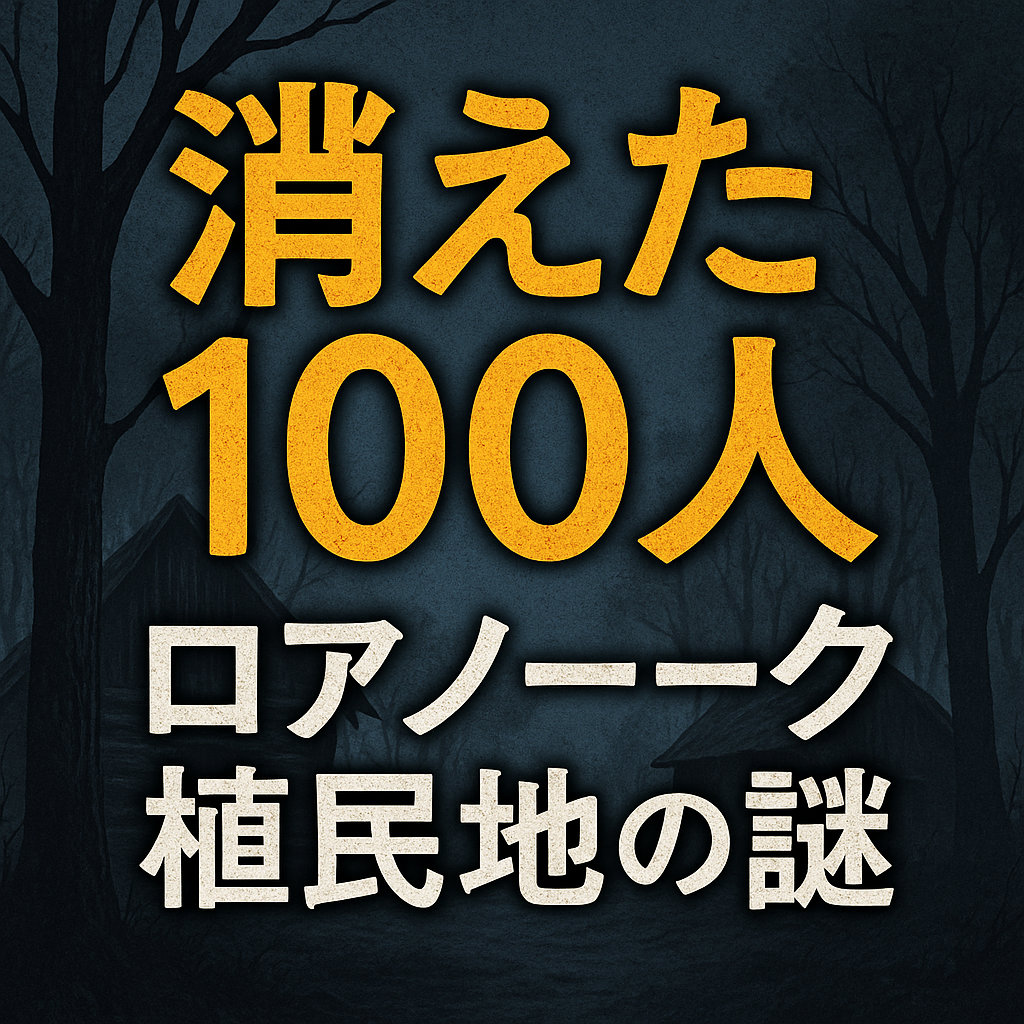ニュースを学びながら英語も学べるブログ / Learn English through News
このブログでは、歴史のミステリーを学びながら、同時に英語表現も身につけられます。
In this post, you’ll explore a historical mystery and learn practical English along the way.
目次 / Table of Contents
- 事件の概要 / Case Overview
- 残された手掛かり / The Clue
- 主な仮説 / Leading Hypotheses
- 事件の余波と現在 / Legacy & Ongoing Interest
- キーワード & 例文 / Key Words & Example Sentences
- まとめ / Summary
1. 事件の概要 / Case Overview
1587年、イギリスからおよそ100人の入植者が、北米東海岸のロアノーク島に植民地を築きました。
指導者ジョン・ホワイトは物資調達のため本国へ戻りますが、戦争の影響で帰還は3年後の1590年になりました。
しかし彼が戻ったとき、入植者たちは跡形もなく消えていました。
家屋に争いの痕跡はなく、村は静まり返っていたと記録されています。
In English:
In 1587, about 100 English settlers established a colony on Roanoke Island.
Their leader, John White, sailed back to England for supplies, but war delays kept him away until 1590.
When he finally returned, the settlement was deserted.
There were no clear signs of battle or destruction—an eerie, unexplained absence.
2. 残された手掛かり / The Clue
現場に残っていた決定的な手掛かりは、木に刻まれた「CROATOAN」という文字でした。
これは近隣の先住民「クロアトアン(Croatoan)族」や、当時その名で呼ばれた島を示す可能性が指摘されています。
ただし、この刻字が「同化・移動」を意味するのか、緊急の合図なのか、確証はありません。
In English:
The only major clue was the word “CROATOAN” carved into a tree.
It may refer to a nearby Indigenous group or a nearby island known by that name.
Whether it indicated assimilation, relocation, or a distress mark remains uncertain.
3. 主な仮説 / Leading Hypotheses
同化・移住説: 生存のために先住民社会に吸収(同化)された可能性。
疫病・飢餓説: 物資不足や病気で集団崩壊し、散り散りになった可能性。
環境要因説: 干ばつなどの環境ストレスが致命的に作用した可能性。
襲撃・衝突説: 小規模な衝突が起き、痕跡が乏しかった可能性。
In English:
Assimilation/Relocation: The colonists were absorbed into a local tribe.
Disease/Famine: Shortages and illness caused the settlement to collapse.
Environmental Stress: Severe drought and harsh conditions proved fatal.
Conflict: A limited clash occurred, leaving minimal traces.
4. 事件の余波と現在 / Legacy & Ongoing Interest
ロアノークは「失われた植民地」として、アメリカ史上屈指のミステリーとなりました。
考古学や文献研究は続いていますが、決定打はまだ得られていません。
この事件は、「手掛かりの読み解き」「複数仮説の比較」という歴史研究の面白さを象徴しています。
In English:
Known as “The Lost Colony,” Roanoke remains a hallmark mystery of American history.
Archaeology and archival work continue, yet no definitive answer has emerged.
It exemplifies how historians weigh clues and competing hypotheses.
5. キーワード & 例文 / Key Words & Example Sentences
- vanish / vanished(消える・姿を消した)
Example: The settlers mysteriously vanished. — 入植者たちは謎の失踪を遂げた。 - carve(刻む)
Example: The word “CROATOAN” was carved into a tree. — 「CROATOAN」という語が木に刻まれていた。 - settlers / settlement(入植者/入植地)
Example: The settlement appeared deserted. — 入植地は無人のように見えた。 - supply run(物資調達の航海)
Example: John White’s supply run was delayed by war. — ジョン・ホワイトの補給航海は戦争で遅れた。 - clue(手掛かり)
Example: The carving was the only clear clue. — その刻字だけが明確な手掛かりだった。 - assimilate(同化する)
Example: They may have assimilated into a local tribe. — 彼らは現地部族に同化したのかもしれない。 - drought(干ばつ)
Example: A prolonged drought could have forced relocation. — 長引く干ばつが移住を強いた可能性がある。 - hypothesis(仮説)
Example: Researchers compare multiple hypotheses. — 研究者は複数の仮説を比較する。 - archaeological evidence(考古学的証拠)
Example: Archaeological evidence remains inconclusive. — 考古学的証拠は未だ決定的でない。 - legacy(遺産・後世への影響)
Example: The case’s legacy fuels public fascination. — この事件の遺産が人々の関心を掻き立てている。
6. まとめ / Summary
ロアノーク植民地は、決定的な証拠が乏しいからこそ、人々の想像力を刺激し続けています。
歴史的ミステリーを追うことは、英語の語彙や表現を学ぶ近道にもなります。
In English:
Roanoke endures because the missing pieces invite inquiry.
Studying such mysteries is also a great way to build your English vocabulary.


